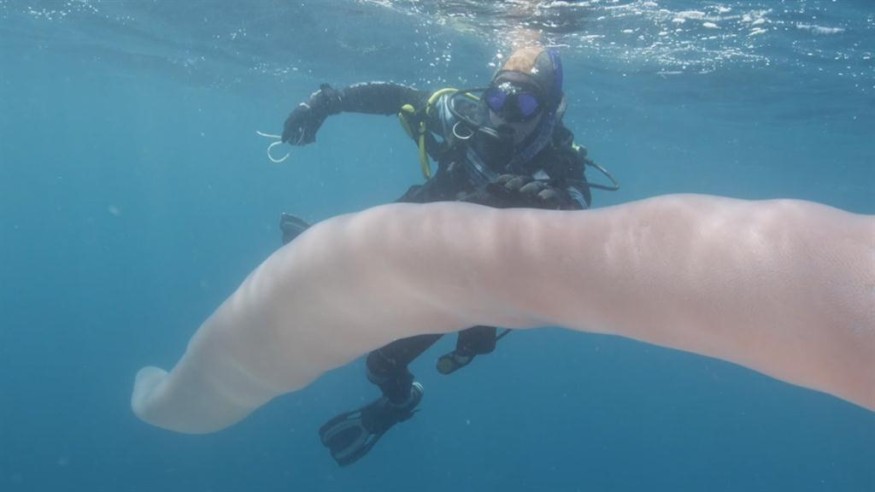This massive worm-like creature was discovered by two divers off the coast of New Zealand. The worm, which is about 26-feet-long, is thought to be a pyrosome, which is an organism found in warm sea waters.
On October 25, filmmaker Steve Hathaway was filming a tourist commercial on an island off the coast of New Zealand when his buddy Andrew Buttle beckoned him over to witness something strange.
After hearing what Buttle discovered, Hathaway said "You've got to be kidding me," . He donned his scuba equipment and dived in. It was a transparent worm-like monster that was 26-feet-long and resembled a big wind sock.

It was a pyrosome, large enough for him to swim across, and he'd been hoping to see one for years.What would typically lead most people to flee the water was something the two guys quickly recognized as completely safe and, in fact, an uncommon occurrence.
Buttle describes swimming around it as "was pretty incredible," "We could see hundreds of thousands of tiny creatures right up close."
This is because a pyrosome is a free-flowing colony of hundreds or thousands of individual creatures known as zooids. Zooids are tiny multicellular organisms that filter feed by pushing water through their body and collecting phytoplankton, bacteria, animal feces particles, and anything else they can clean up.
Because they pump water into one siphon and out the other, they are classified as tunicates, sometimes known as "sea squirts." What about another moniker? "Sea cockroaches," for their capacity to filter food out of even the most hostile conditions.
Pyrosome and Salp
According to Andrew Jeffs, professor of marine science at the University of Auckland, the pyrosome and its cousin, the salp, are both "hugely important and super abundant" as a food source in mostly tropical seas. Both are sustenance for sea animals such as turtles and spiny lobsters, Jeffs' specialty.
Predators may cling to the tubes and dine for weeks. It's like hanging off an elephant and eating it," he adds. "They can afford to take the time and nibble on enough to get the goodness from them." However, animals frequently die as a result of ingesting plastic bags that resemble them or other gelatinous creatures such as jellyfish.
Pyrosomes eat by swimming vertically to the ocean surface at night to capture phytoplankton and then returning to the depths when daylight arrives, maybe to avoid predators that feed during the day.
Also read : A Strange Sea Worm with Branches.... for Butts!
The 26-foot Sea Worm
The pyrosome is a tubular, gelatinous substance that glows due to spontaneous bioluminescence. They can be as little as a centimeter in size or as large as (or larger than) the one in the video. Salps, which are formed up of one zooid and are more frequent, have received more attention than pyrosomes. In 2017, the West Coast saw a massive pyrosomine
Summer's warmer temperatures attract a variety of aquatic creatures. "Around this time of year, you always see something new," Hathaway adds. He'd seen enough aquatic life in his 11-year cinematography profession, including manta rays and whales. He and Buttle ended up swimming about the pyrosome for almost forty minutes this time.
He plans to incorporate this expertise into his educational entertainment platform for children, Young Ocean Explorers. "I'm sure the kids will enjoy it," he says. "It appears to them to be a massive worm. Sometimes it takes something unusual to bring people to a halt."
© 2025 NatureWorldNews.com All rights reserved. Do not reproduce without permission.




